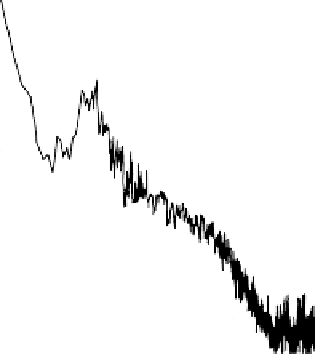Geoscience Reference
In-Depth Information
33.027, Punta Lobos, Peru
March 12, 1983
107.8 km
108.1 km
108.4 km
45.0
0.0
245.0
116.0
116.5
117.0
Time (sec. after 10:34:36 L.T.)
10.0
0.0
210.0
2
20.0
230.0
2
40.0
250.0
2
60.0
270.0
2
80.0
1
10
100
1000
10000
Frequency (Hz)
Figure 4.31
Raw data and the spectrum of pure two-stream waves in the daytime elec-
trojet. The peak signal occurs when the detector is parallel to the current and the spectrum
maximizes at a wavelength of a few meters. [After Pfaff et al. (1987b). Reproduced with
permission of the American Geophysical Union.]
As we shall see following, these data are remarkably well organized by the
linear theory into a pure “two-stream” instability at and above the peak in
plasma density, a pure “gradient drift” instability well below the peak, and a
mixture of the two just below the peak.
4.7 Linear Theories of Electrojet Instabilities
Two mechanisms can efficiently amplify thermal density fluctuations in the
equatorial electrojet. These mechanisms result from plasma instabilities known
as the two-stream instability and the gradient drift (also known as the cross-field
instability).
Many features of the type 1 irregularities are explained by a modified two-
stream instability theory developed independently by Farley (1963), using kinetic


Search WWH ::

Custom Search